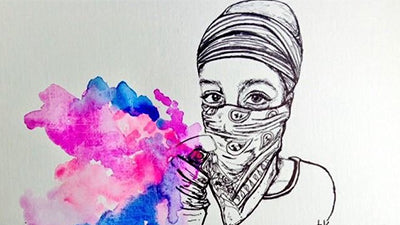Tell us about yourself?
My name is Talveen Kaur, an artist from Brampton, Ontario.
Describe your style of art.
I don't have a definite style of art. However, my art usually focuses on watercolour portraits of influential leaders of the Sikh panth, or try to create a sense of empowerment when creating sketches of Singhnia. Also, I freestyle when creating landscapes, which usually include a Nihang Singh. When creating portraits I tend to put more detail in and around the gurmukh's eyes, and try to depict their prem towards Sikhi in itself, and usually tend to get positive feedback when the audience can feel a connection. When I first started creating small sketches of Singhniya carrying arms or ak47's I put it out there for the purpose of empowerment. It feels as if there are a lot of Singhs that are being depicted in artwork, and most of the time the focus is put on them and their contributions to the Sikh panth, when there is barely any on the women. Don't get me wrong, there are so many soormeh out there that have done so much for the panth, but we usually aren't recognizing the contributions our women have made. The feedback I've received from Singhniya about the artwork simply encourages me to create more for them, it makes them feel powerful and that alone is just enough for me to create more pieces as such.
How did you first get into your art?
It first started as a hobby and I didn't think much of it, but later I started using it to express the social and political circumstances of those in the Sikh panth. Then later, as my art began to grow I started to free style more, and experimenting more with colour and watercolours, trying to depict the traditional aspects of Sikhs as well.
At what point did you realise you may excel in this?
It was in the beginning of high school when I was encouraged by my friends and my art teacher that art may just be the thing for me.
Considering the stereotype of some Asian parents, what do your family think about what you do?
It usually does come off as a hobby, but when looking back, and even today, my mom has never rejected me once in when it came to buying art supplies. My grandfather was always very supportive of art and pushed me further to pursue my passion. In its own way, it all has been supportive even though at times it may not come off as that, I always know they have my back.
How does inspiration find you for your art?
I don't really need to carry a sketchbook with me. I usually find myself observing detail in others or the nature around me, which I then keep at the back of my mind. Then from there I usually find it again on a canvas when creating , or as a sketch.
Have you gone through a period when inspiration has been hard to come by?
With so much around me, there has been constant inspiration everywhere. At times I did have to look for it, but art and energy is everywhere. It comes to terms with understanding it and then putting it to paper.
Take us through your creative process.
Once an idea finds me I usually have to create right then. I usually paint or create at one certain place as I am most comfortable but if so I can be pretty flexible when it comes to where. If it's a freestyle painting then it usually doesn't take as long, however there's more detail work that goes into making portraits, so that's when it may become a little frustrating or take more time.
Who are your artistic inspirations?
The women around me are so inspiring and empowering. Recently, a writer from Brampton released her first book Milk and Honey that depicts femininity and the struggle and love we experience through life. Her work leaves me speechless and so inspired. Another artist Kiran Rai, from Brampton, recently released her first short film Kirpa, which focusses on the struggle a young South Asian artist goes through, and did an amazing job. And at last, I owe everything to Anoop Caur Virk. When I first got into Sikhi and started art, I came across her page and was simply blown away by this Singhni's work and talent. She's been the biggest inspiration for me so far and has always looked out for me as a young artist, and I can't thank her enough for all she has done for me. It's hard being a young South Asian artist, and to have the constant support of Anoop has really helped me through so much. I only hope that one day I can be as she has been to me, for someone else. She continues to be my inspiration on a daily basis and I owe everything to her being.
How do you find showcasing your creation and do you go through any rituals prior to showcasing?
Whenever I'm too scared about presenting a piece I usually run it through another artist, Mandeep Singh Kalsi, or my best friend Harman Kaur. They usually know what's best and are my best critiques before I put my art out there for other people to see.
Tell us about a particularly popular creation and why you feel it was so appreciated
I've gotten a lot of feedback about two particular pieces, the ones that have a forest background with a Nihang Singh on a horse. Those two pieces were freestyle and were created while listening to the shabad "Joojhgey Randheer Saavaat Padam Tees Jujhar" I had first heard the shabad at a youth kirtan darbaar where Jora Singh explained the Raag in which it was in, Raag Basant in Sri Sarbloh Prakaash Granth Sahib Ji, where Guru Gobind Singh Ji Maharaaj dedicated the entire Raag Basant to warriors and soormeh, who bloom like flowers in the spring ready for war after taking a break in the winter, as battles resume in spring. The shabad explains what goes through ones mind when going into battle, and prepares them to become shaheed. As an artist I had to capture this and depict it in a piece. I painted a spring like atmosphere using bright colours around the lone Singh. When I posted it the feedback was amazing, and many were attracted to the piece.
What would you consider your biggest achievement as an artist thus far?
As an artist my work is out out there to connect and empower others, and as well to inspire them. After I had a posted a piece I had received a picture of another painting from one of my friends, saying I had inspired her to paint again. That has been my biggest accomplishment so far, and I hope that as I grow as an artist, others become inspired and pursue their passions as well.
How do you look to improve as an artist?
There is always room for improvement and I hope that I can learn more skill so I can create more effectively, in which the audience can feel a connection or further work on stirring emotion.
Do you have anyone you would particular love to work with?
I've already collaborated with one of my greatest inspirations, Anoop Caur and further look to more projects with her. However, I'm looking forward to creating pieces with other individuals from other countries so the artwork can expand and target a greater audience.
What do you do to relax?
Usually painting is a great way to unwind and get all messy thoughts on paper. But I usually immerse myself with sangat or find my self at kirtan darbaars to relax.
Tell us about the relationship between your Sikhi/Punjabi background and your art?
After discovering Sikhi, it has heavily influenced my artwork. A lot of my work is shaped by those of the panth and the traditional Sikh lifestyle. I strongly believe that our Guru's were all artists, they've taken an energy and mastered the art of enlightenment through writing, and created more than just a connection between us and Akaal Purakh. This relationship gives me a purpose to serve the community with artwork so that they can feel a connection to what they are rooted from.
In an ideal world, where would you like your art to take you in life?
I aspire to teach art one day and hope that I can live as an inspiration to those who practice it as well.
If you could showcase your work anywhere in the world, where would you do it and why?
I'd say I'd like to take it back home to Punjab, to see my artwork where it is most inspired from is one of the goals I wish to accomplish. Simply because I want my art too meet the energy that has led to its creation, and just to have it showcased in a place full of culture.







